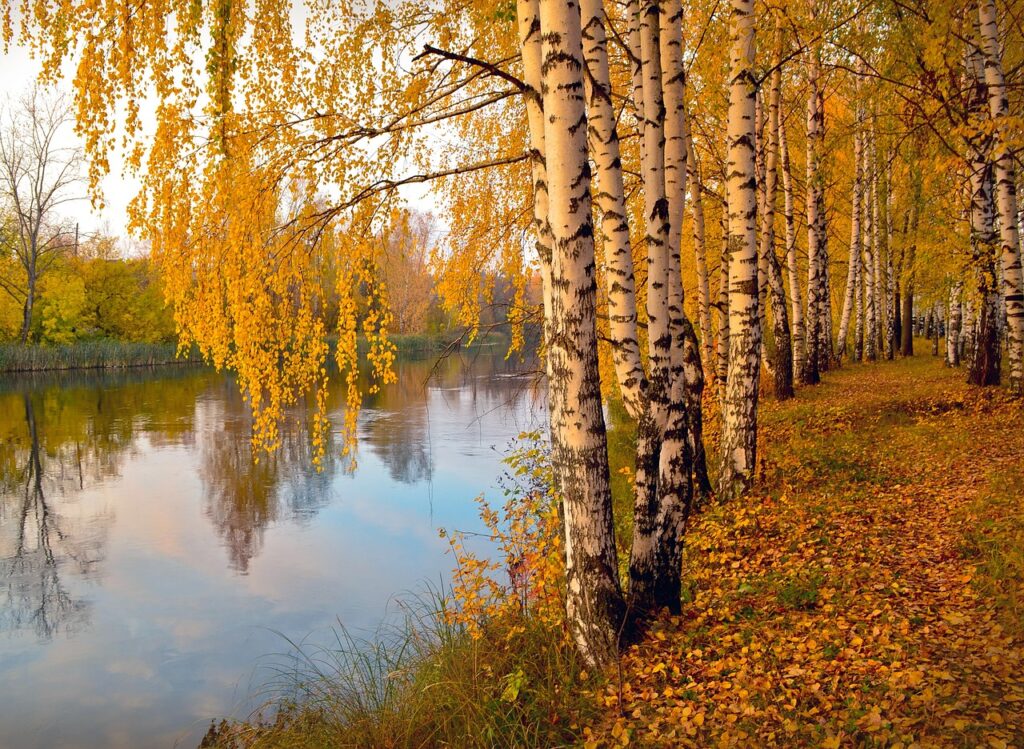
Sweden
Birch
Betula verrucosa and Betula pubescens

General Description / Cultural Significance
The Nordic country of Sweden is represented by the native deciduous Birch tree. Though the nation is vastly covered in forests, it’s the higher mountain regions that contain the more densely populated collections of the attractive sweet-smelling Betula verrucosa and Betula pubescens. The tree line elevations in this area can range anywhere from the heights of 1,600 – 2,900 feet.
The cultural significance of the plant can be expressed through the country’s selection of its national tree: the Ornäs Birch. Two cloned saplings from the original mother can still be found on a small farm in Lilla Ornäs. The B. verrucosa and B. pubescens play an important role in the national holiday of Midsummer, too. Birch twigs help construct the maypoles that for centuries have been used in important rituals and dances that circle the standing structure. Over time, the meaning of the holiday has evolved from Christian to Pagan, but the construction of the maypole has always needed Birch, which like the maypole, has always been a symbol of fertility.
The Birch tree is also used across Sweden as a culinary ingredient. Birch bark flour has been harvested in Sweden for centuries and is used in bread recipes to give bread structure and make dough more cohesive. In the springtime, the Birch tree is ‘tapped’ and the tree’s sap trickles out into a bucket from which it can be drunk fresh, brewed into beer, or boiled down into syrup. Birch leaves have been used as a tea for thousands of years to strengthen the immune system and fight inflammation.
The atmosphere of walking in a birch forest in northern light with hundreds of trees with a bark of pale grey to white peeling papery patches and black lines is a beautiful experience and an aesthetic. The trees are an inspiration that has made its way into culture in the form of many decorative items. Underneath the bark is a strong and durable hardwood popularly used as veneers in furniture and cabinetry.
Climate Change / Conservation Status
While Birch trees are endangered in other parts of the world, the plant flourishes in temperate climates like Sweden. Since the 1980s, the winters have been continuously warmer. Because of this, the Birch tree elevation line has moved higher. The tree has taken up territory farther north and is expected to continue with this pattern. This migration has helped Birch continue to flourish, but it is creating havoc on the biodiversity of higher regions as new birch seedlings take displacing other native species. Expert opinions vary on the severity of these ecological changes, but the migrating Birch is certainly bringing the threat of wildfire to higher regions.
Due to changing climate and drier seasons, frequent wildfires are increasing with devasting effects. The summer of 2023 is poised to produce its deadliest season of wildfires since 2018 when fires in the north caused a 1.2-billion-dollar loss in agricultural production. This year, an absence of rain and hotter temperatures has created a dryness that is already producing wildfires. These fires affect the Birch trees in both the present and the future. Research reveals that if fires continue, soils in the affected forests will begin to lose their capacity for carbon storage and other nutrients essential for Birch growth.
Wildfires on this scale can only be resolved by fighting climate change. Luckily, this is a practice in which Sweden is a world leader and pioneer. The country’s biggest goal, currently, is to be 100% fossil fuel free by 2045. This is noteworthy as fossil fuels have been directly linked to the increased damage that wildfires can cause. Sweden is committed to the preservation of the Birch and our planet.
Alternate Names
Silver Birch
European White Birch
Warty Birch
Sources
Consulate General of Sweden, Swedish Information Services New York, New York. This statement can be found on the World Sensorium Original Website.
Global appetite for resources pushing new species to the Brink – IUCN Red List. IUCN. (2022, June 27). https://www.iucn.org/content/global-appetite-resources-pushing-new-species-brink-iucn-red-list.
Encyclopædia Britannica, inc. (n.d.). Climate of sweden. Encyclopædia Britannica. https://www.britannica.com/place/Sweden/Climate.
Ugc. (2020, July 30). The original Ornäsbjork. Atlas Obscura. https://www.atlasobscura.com/places/the-original-ornasbjork.
Ostberg, R. (n.d.-a). Midsummer. Encyclopædia Britannica. https://www.britannica.com/topic/Midsummer-holiday.
The forest and Sustainable Forestry. Swedish Wood. (n.d.). https://www.swedishwood.com/wood-facts/about-wood/wood-and-sustainability/the-forest-and-sustainable-forestry/.
Biodiversity in Sweden. Climatechangepost.com. (n.d.). https://www.climatechangepost.com/sweden/biodiversity/.
Kelly, J., Ibáñez, T. S., Santín, C., Doerr, S. H., Nilsson, M. C., Holst, T., Lindroth, A., & Kljun, N. (2021). Boreal forest soil carbon fluxes one year after a wildfire: Effects of burn severity and management. Global Change Biology, 27(17), 4181-4195. https://doi.org/10.1111/gcb.15721.
Tanner, J., & Ritter, K. (n.d.). Drought and rising heat bring unusual wildfire warnings in Northern Europe. Los Angeles Times. https://www.latimes.com/world-nation/story/2023-06-16/drought-and-rising-heat-bring-unusual-wildfire-warnings-in-northern-europe
(n.d.). What does a hotter planet mean for wildfires? Environmental Defense Fund. https://www.edf.org/climate/heres-how-climate-change-affects-wildfires
Birch trees. Reindeer and Fishing. https://reindeerandfishing.fi/birchtrees1/

